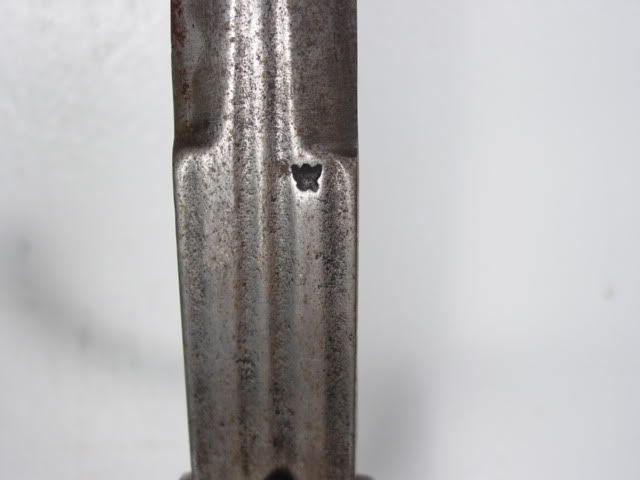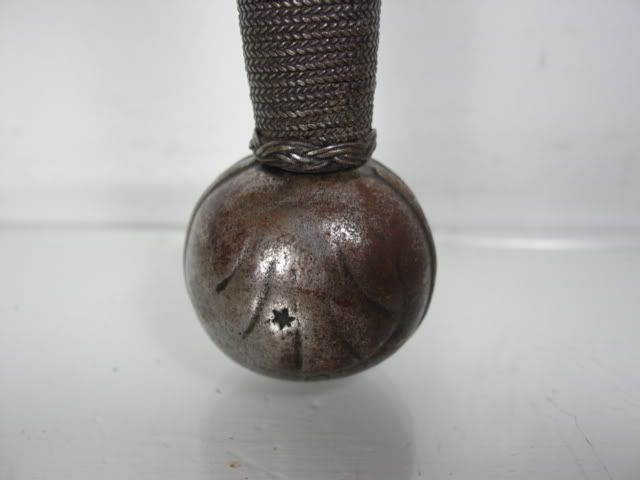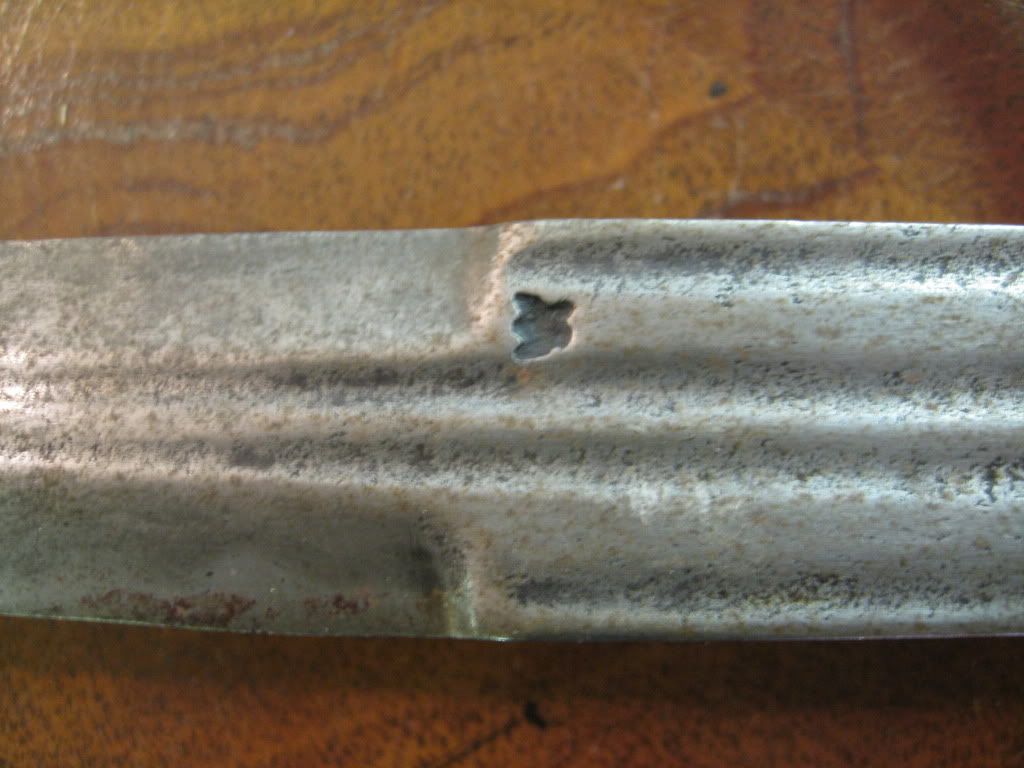
 |
|
|
#1 |
|
Member
Join Date: May 2010
Posts: 20
|
I purchased this sword a few years back. It was listed by the seller as a "c.1600 Italian Arming sword." It is about 37 inches long and weighs about 2 lbs, very well balanced. However, I have never been able to match the marks to any particular maker or arsenal. Any ideas?
    
|
|
|

|
|
|
#2 |
|
Member
Join Date: Dec 2009
Posts: 140
|
Hi,
i scanned my marks register a while ago at this tread http://www.vikingsword.com/vb/showthread.php?t=11918 there under A890 is a mark which shows a star and a half moon like yours. It belongs to a serving knife from 1600 made in england I will scan the text as well if you are interested Dirk |
|
|

|
|
|
#3 |
|
Arms Historian
Join Date: Dec 2004
Location: Route 66
Posts: 9,948
|
Good call on checking the Wallace reference Dirk, and the scan shows how profusely comprehensive this book is on markings. The star over crescent is most interesting and described as a cutlers mark on the blade. What is different between this paired mark is primarly that on Carl's sword, the crescent appears on one side of the pommel, while the star, which is six pointed rather than five, is on the opposing side of the pommel.
The text suggests with question mark, that the knife is German c. 1600. Going further through Wallace Collection (Laking, 1962), I found that the closest think to the blade mark here would be on a German hand and a half sword (A488) dating c. 1600. It should be noted that these marks on this sword were paired rather than single. Laking notes that these type marks, which occur in multiples as well as singly on blades, are most often associated with Italian blades, and are often referred to as 'twig marks'. This type marking seems a bit different, positioned vertically and with three point crown type profile. The blade on this seems consistant with another hand and a half type shown as c. 1550 Italian (A550) with the central raised median and hexagonal cross section. In going through "Armi Bianchi Italiene" (Boccia & Coelho, 1975) I found no exact parallels to this sword in particular, however the crab claw guard and general shape seems consistant with the basic version of more developed hilts in Italian swords of the period. I would consider that by 'arming sword' it is meant to be a simpler 'fighting' sword and as such, not of as much attention in general weapons studies examining the finer form hilts. It should be noted as well that Germany and Italy were in considerable contact as well as competition in arms and armour in these times, and there are many close parallels as well as expected diffusion of style and even markings. It would difficult to determine a distinct makers work by these obscure markings today as they were widely varied in use, and pertinant at the time and location probably in terms of guild compliance and work orders etc. Like most markings, these became widely copied on trade blades and served as tacit suggestions of quality that were even copied by native imitators in many colonial regions. The star and crescent on the pommel of this sword suggest also some type of makers contract or compliance stamp and are seen on blades in the expected variation in North Italy from 16th into 17th century. Best regards, Jim |
|
|

|
|
|
#4 |
|
Member
Join Date: Oct 2007
Posts: 2,818
|
Carl,
May I please suggest removing that brown rust starting to appear on all surfaces and wax the entire piece. I'd also suggest buying some gloves to handle it, nothing worse than watching fingerprints turn in to rust!!! Neat sword too, I love simple form items as much as those dripping in embellishments. Gav |
|
|

|
|
|
#5 |
|
Member
Join Date: May 2010
Posts: 20
|
Junker,
Where did you get that book" I have been looking for a good makers mark reference book. I would have to agree with Jim that the markings are different. Jim, Thank you for your input, that is very helpful. I was told the sword was Italian by the guy I bought it from. The seller also claimed that the guy he bought it from got it as a deaccession from the metropolitan museum many years ago for whatever that is worth. The research I have done on this sword indeed says that those marks are called "twig marks" but no firther information is found. I did find one exact match in of that twig mark in a French arms and armor book from the 1980's. The matching sword that has the mark in the book is listed as Italian from about 1580. The sword with the mark is a "case of rapiers," or more specifically a sword that splits in half to become two swords. When you mention "Wallace Collection (Laking, 1962)," are you referring to specific book? I am wondering if the pommel marks can me arsenal marks. Freebooter, That pic was taken on a table in the antique shop I bought it from. The pic makes it look worse. I always handle with gloves. However, I have heard varying opinions on renaissance wax, and Butcher's bowling alley way (which they use at the Higgins). One British conservator on a Conservitors mailing list said that research has shown Butcher's wax to cause corrosion over time. I have used mineral oil in the past to lightly wipe down my blades, and I have never seen any rust. What is the consensus on here regarding Renaissance wax? |
|
|

|
|
|
#6 |
|
Arms Historian
Join Date: Dec 2004
Location: Route 66
Posts: 9,948
|
Carl, Im glad the information was helpful, and wanted to thank you for the personal response, it is indeed very kindly appreciated. Also, thank you for the opportunity to learn from this sword and for sharing the research you have already completed, another extremely appreciated courtesy which is the core of what this forum is supposed to be.
The book Junker referenced with 'marks register' is actually the same reference I had indicated but that I miscited the author as Laking, when actually it is Sir James Mann. It is the two volume set of "Wallace Collection Catalogues: European Arms & Armour" , Sir James Mann (London, Wm.Clowes and Sons, 1962). These volumes are outstanding and often used references which is why they are often mentioned in discussion complacently as 'Wallace Collection' much as is the venerable volume by George Cameron Stone. It was Sir James Mann who used the term 'twig marks' regarding these curious pronged marks in this book. It would seem these occur in a number of variations, as well as multiple configurations on North Italian blades from 16th-17th century, I believe even earlier. As I mentioned, these were so widely used in variation, it is hard to say exactly what they represented, but may be presumed to have guild compliance in the sense of probably quality guarantee. As such they defy distinct association to particular makers, but it does seem it might be possible to identify certain variations to one or a group of makers, though this has not been accomplished as far as I know. For makers marks, the Wallace Collection book is probably one of the best as the late Sir James Mann was extremely highly respected for his attention to detail in the study of arms and armour, and his attention in text to the marks is quite a milestone. Other references such as Gyngell, Lenciewicz et al, are more compendiums of marks with no detail or text and often arbitrary attributions. Im really glad you have joined us, and thank you for sharing this very nice example!!! Best regards, Jim |
|
|

|
|
|
#7 |
|
Member
Join Date: May 2010
Posts: 20
|
Thank you, Jim! This is a great forum! I have many other antique swords that I would like to post on here and learn more about!
I am definitey going to get that two volume set by Sir James Mann. |
|
|

|
|
|
#8 | |
|
Arms Historian
Join Date: Dec 2004
Location: Route 66
Posts: 9,948
|
Quote:
 but its up to all of us to make it that way. The idea here is to post away, and not hesitate to express ideas and observations, we all learn together. There are no experts, and we use whatever resources we have and share results. but its up to all of us to make it that way. The idea here is to post away, and not hesitate to express ideas and observations, we all learn together. There are no experts, and we use whatever resources we have and share results. Really looking forward to your posts, and really glad you're here. All the very best, Jim |
|
|
|

|
|
|
#9 | |
|
Member
Join Date: Jul 2006
Location: Buraimi Oman, on the border with the UAE
Posts: 4,408
|
Quote:
In my store we rack up about 30 swords which have to be cleaned every week as people invariably touch the blades and their fingers create an acid print if they are left ... I use sewing machine oil as its simple and fast to apply and wipe down the blades .. Wax is ok but the oil is both quicker and cheaper. Some wax contains moisture which doesn't help. Restoration Wax is good and used by the experts but for us~ and believe me I have used all kinds of stuff including hair oil and floor wax...( I mean here in outer arabia we use what is available !!) sewing machine oil is the top stuff. Its great because it has a long nozzle so you dont waste any...Its made in Japan and goes by the trade name "Grape"... Super Oil .... and is in 3 ounce plastic bottles. Im sure you can find the equivalent . Regards, Ibrahiim al Balooshi. Last edited by Ibrahiim al Balooshi; 14th September 2011 at 05:44 PM. Reason: text change |
|
|
|

|
 |
|
|